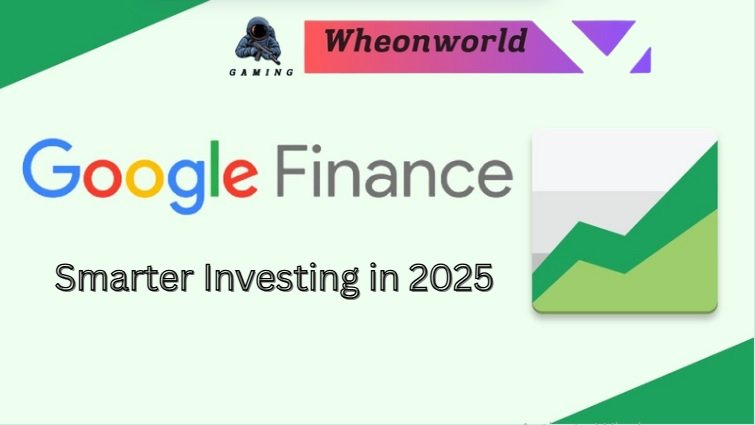In today’s digital age, tracking your investments and staying updated with marketplace actions is essential. Google Finance has come to be a cross-to platform for 10 millions of buyers, providing real-time inventory charges, monetary information, portfolio monitoring, and greater. Designed for novices and pros alike, Google Finance simplifies market records and insights into one user-friendly interface.
Whether you’re checking stock performance, global indices, or company news, this free tool is packed with features that help you make informed decisions in just a few clicks.
What is Google Finance?
A Brief Overview
Google Finance is a free financial information platform provided by Google. Integrated with Google Search, Google Sheets, and News, it delivers:
- Real-time stock quotes
- Company news and earnings data
- Market trends
- Cryptocurrency tracking
- Custom portfolios
Unlike complex financial software, Google Finance is intuitive and accessible to anyone with a Google account.
Features of Google Finance
1. Real-Time Stock Tracking
With Google Finance, you get instant access to live stock prices, performance charts, historical data, and trading volumes. Just type a ticker (e.g., AAPL, TSLA, or TATASTEEL) in Google Search, and a detailed card appears.
2. Google Finance Portfolio
The portfolio tool lets users create watchlists or track their investments. It provides:
- Current prices
- Price changes (%)
- Daily gains/losses
- Market news related to your stocks
You can easily create a custom portfolio to monitor your assets.
3. Google Finance Stock Screener
While not as detailed as paid platforms, Google Finance stock screener offers:
- Basic filters (sector, market cap, country)
- Sorting by % change, volume, etc.
- Integration with Google Sheets for advanced analysis
How to Use Google Finance
Step-by-Step Guide
1. Search for Stocks or Companies
- Go to google.com/finance
- Enter a company name, ticker, or index
- Explore tabs like Overview, Performance, News, and Financials
2. Create a Watchlist
- Click “+ Follow” on any stock or index
- Your followed stocks appear on the homepage
3. Link to Google Sheets
- Use the =GOOGLE FINANCE() formula
- Example: =GOOGLE FINANCE(“GOOG”,”price”) returns the current price of Google stock
4. Set Google Finance Alerts
Use Google Alerts or third-party apps to track:
- Stock price changes
- Breaking financial news
- Earnings reports
Benefits of Using Google Finance
1. Free and Easy to Use
No subscription required, unlike Bloomberg or Morningstar. The interface is clean, fast, and ad-free.
2. Ideal for Beginners
Basic data presentation helps newcomers understand the markets without being overwhelmed.
3. Integrates with Google Workspace
If you use Google Sheets, Docs, or Drive, your financial planning becomes seamless.
4. Mobile Accessibility
While there’s no dedicated Google Finance app, the mobile site is responsive and works well on smartphones.
Limitations of Google Finance
1. Lacks Advanced Analytics
It doesn’t offer technical indicators like RSI, MACD, Bollinger Bands, or candle patterns.
2. Limited Data for Global Markets
While it supports Indian, US, and European markets, some global exchanges and small-cap data may be unavailable.
3. No Dedicated App
Unlike Yahoo Finance or Investing.com, Google doesn’t offer a native finance app for Android or iOS.
Google Finance vs Yahoo Finance
| Feature | Google Finance | Yahoo Finance |
| Interface | Clean, minimal | Rich, slightly complex |
| Stock Screener | Basic | Advanced filters available |
| News Aggregation | From major publications | Yahoo-owned and external |
| Mobile App | ❌ No | ✅ Yes |
| Real-time Alerts | ❌ Limited | ✅ Advanced push alerts |
| Integration with Sheets | ✅ Google Sheets compatible | ❌ Not natively |
Google Finance and Cryptocurrency
With crypto trending globally, Google Finance has added real-time crypto tracking. You can monitor:
- Bitcoin (BTC)
- Ethereum (ETH)
- Dogecoin (DOGE)
- Market cap & 24-hour change
Search directly or use Google Sheets for dynamic crypto charts.
Tips for Getting the Most Out of Google Finance
- Bookmark your custom dashboard
- Use =GOOGLEFINANCE() in Sheets for personalized dashboards
- Enable Google Alerts for key tickers
- Watch YouTube tutorials to master Sheets-based portfolio tracking
Google Finance for Indian Users
India’s retail investor base is growing. Google Finance India offers real-time data for:
- NSE & BSE stocks
- Nifty 50 and Sensex
- Mutual funds (limited)
- Top Indian companies like Reliance, TCS, Infosys, and HDFC
Use Cases: Who Should Use Google Finance?
| User Type | How Google Finance Helps |
| Beginner Investors | Track stocks and learn without complex tools |
| Students | Analyze historical data for projects via Sheets |
| Financial Bloggers | Integrate stock data into Google Docs/Sheets for reports |
| Crypto Traders | Basic crypto tracking and comparison |
| Passive Investors | Monitor long-term portfolios with minimal setup |
Future of Google Finance
As of 2025, Google is rumored to be enhancing:
- AI-powered suggestions
- More robust API support
- Native app launch
- Collaboration with Google Bard & Gemini AI for investment summaries
This will further increase its value as a one-stop financial solution.
Summary
Google Finance is a powerful yet simple tool for investors, students, and market enthusiasts. Whether you want to track stocks, analyze data with Google Sheets, or stay updated on financial news, it’s an efficient, free platform. While not as advanced as some premium tools, Google Finance remains a favorite for its clean interface and Google ecosystem integration.
FAQs of Google Finance
Does Google Finance have an app?
Currently, no dedicated app exists, but the mobile site is fully functional.
How do I track my portfolio on Google Finance?
You can follow stocks directly on the site or use Google Sheets with the =GOOGLEFINANCE() formula.
Can I get real-time alerts from Google Finance?
While Google doesn’t offer push notifications, you can use Google Alerts for email updates.
How accurate is the stock data on Google Finance?
It is generally accurate and real-time for major exchanges, but not ideal for penny stocks or smaller international markets.
